General Kulnieff (Russian Vanguard) After Action Report, Part 1
"Hmm...", said General Kulnieff to himself as he looked at the orders he had just received from his commander, General Wittgenstein. "Looks like the big show is on!"
"Sub-leutenant Kolodumbski!", shouted Kulnieff. "Order the scouts out! Order the troops to form! We move on Danowiczy!"
With that there was a flurry of activity as Kulnieff's Russian Vanguard broke camp, formed up, mounted up and moved out with celerity. The army's survey officers and Kulnieff's scouts had prepared maps of the local area so Kulnieff felt he had a good understanding of the local road network leading from his starting positions, shown as follows.
Above map shows the campaign map local to Kulnieff's position, with the rectangles representing what he believed were the likely table maps with which he was already familiar. The known table maps were Katerinova (northernmost), Swolna, Wolinizi (southernmost) and Drissa (westernmost), with Kulnieff's forces starting at the Swolna position. Danowiczy is just off the right center of the map (where the "D" just shows). The expected interconnections between the tables should be self apparent.
Imagine Kulnieff's surprise when his Independent Brigade, preceding his main force, reported almost immediately that exit S3 led to Disna, NOT Danowiczy. Kulnieff immediate presumed his map makers had yet again failed him and turned his force down the Sastenok road to exit S2, presuming both Wolinizi and Danowiczy MUST lie in that direction.
As it happens, Kulnieff expected the Swolna table connections ("to XXX") as shown below. Also indicated are what turned out to be the actual connections as reported to Kulnieff during the game ("actual XXX") .
The Cossacks had meanwhile reported that the Swolna table's S4 exit as expected indeed did connect to Katerinovo and that Wittgenstein had sent a considerable force to cover the north. Seeing they would be of no aid up north, Kulnieff ordered the Cossacks to return to his main force.
On exiting at S2 from the Swolna table, Kulnieff again found his forces on the Disna table and no less than that, had the French General Merle (the Swiss commander) on lower ground below him, the ground sloping towards the Dwina River in the distance. The Swiss seemed ill positioned and ready to be destroyed by Kulnieff's vanguard as well as the fellow Russian commander entering just then in the Swiss rear. A classic hammer and anvil attack to crush the Swiss before help could arrive!
Aha! So there WAS no road to Danowiczy. Well, his scouts in previous days had reported dubious travel conditions there. Clearly the roads had washed out or something. So, if he could not get to Danowiczy, then clearly the French could not get to him, even should they be able to reach Danowiczy. What was a poor general to do then but seek glory and death and find some French to kill !!
Kulnieff could head north to Katerinovo and then east to Jakoubowo, aiding the Russian drive into what hopefully was a vulnerable French rear. But that would entail a long march plus potentially leave the Swolna road open to the French getting into the Russian rear! No!! If the Russians had no way to get to Wolinizi then neither did the French. Far better to attack forward, guarding the lines north as well as engaging and keeping the French south. Kulnieff had full faith that at very worst his men could certainly stand the rest of the day against anything the enemy might throw at them. With a bit of luck, they could do much more. Clearly Kulnieff had found a point of nexus in the road network!
So! His blood up to destroy the vulnerable French before him, Kulnieff ordered his troops forward, forming battle line preparatory to crushing the enemy opposite.
Still..., something nagged at the back of Kulnieff's mind. He could not quite place his finger on it. But..., how was it possible that the army map makers had so clearly indicated Wolinizi was just south of Kulnieff's bivouac at the Swolna position and yet Kulnieff's scouts had not found any road leading to Wolinizi? How was that possible....?
Ach! No doubt! Just one more screw-up by that incompetent staff of Wittgenstein's! No! Waste not time chasing possible French up north when there was not a way around or way behind him and his men. Kulnieff and his men would at the least stand proud where they were, and with luck, roll forward, crushing the hated enemy! Praise Mother Russia!!
Kulnieff got off a hasty message informing Wittgenstein he was engaging the Swiss at Disna, unfortunately forgetting to inform the supreme commander there was no route available to Danowiczy.
Fortunately, but what seemed moments later, Wittgenstein himself arrived on the battlefield at Disna, and Kulnieff was able to inform the commander that there was clearly no route to Danowiczy and therefore no route the French could follow to hit us from that direction.
Still..., there was that nagging doubt about why his men had failed to even find Wolinizi...
No mind! Attack! An attack fully approved by Wittgenstein on the spot. (Well, truthfully, he didn't say NOT to attack...). Push the men forward!
So..., for the rest of the day the sides hammered away at each other. The Swiss, damnable Swiss refusing to give way and even thrashing the Russians attempting to hit them in the rear. Meanwhile, French reinforcements start appearing from Polotsk (from the left side of the photo below), forcing Kulnieff to open and re-orient his line. Still Kulnieff moves to threaten the Swiss left flank.
In Part 1 of Kulnieff's AAR, we covered up to the initial engagement with the enemy at Disna.
In the early afternoon, French reinforcements attempted to force their way across the Dwina River bridge from Disna, opposed by scattered Russian forces arriving from Drissa.
And then to make matters worse, from the Polotsk road French Cuirassier appear! What to do? What to do?
Kulnieff cooly launches his own cavalry at the incoming French horse and horse guns, buying time to properly form his line for what he knows is the coming assault.
Now word suddenly arrives! There has been a duel, mano a mono, pied a pied! Our spy has found the enemy spy, face to face and they challenge to a duel.
They stand, facing one another across the river, each confirmed in the righteousness of his cause!
Then suddenly! Shots ring out. A pair of pistols fired! One man falls! It is the Frenchman! Our man wins!
Word spreads up and down the line like wildfire. Kulnieff's men take heart. They reform the line. Little matters the truth of the affair! They now stand firm.
But yet the worst is to come!
The French Cuirassier form in the distance. Kulnieff coolly orders a change of face of his guns and that they be brought up hub to hub, wheel rim to wheel rim. If French Cuirassier want to come, let them first brave hot Russian shot.
They start their charge. Onwards they come, magnificent in their steel vests, the late afternoon sun burnishing them with a terrible shine. The guns hold their fire. The men wait, squares formed to either flank, the men knowing fresh Russian cavalry back them to their rear. Let them come. Mother Russia is prepared!
Onward the charge, first a walk, then the trot. Now the Russian grand battery opens up. the men in ranks lower their bayonets. Shot and shell start taking effect, but still the magnificent of the magnificent French come onwards until they reach but the very mouth of the guns. Rank after rank of French horsemen go down. But still they come on.
Then suddenly - there's a falter in the horsemen's ranks. Cuirassier pull up, their horse rear, men are thrown from their saddles. And then just as suddenly as it started, the feared heavies are in retreat, running from shot and shell of the massed Russian guns. Repulsed and fallen back. A great cheer erupts from across the entire Russian line!
The fighting continues for some time, with Russian charge of French horse guns, resulting in a bloody repulse, the French guns left holding their own private portion of the battlefield. The scattered Russian horsemen, rather than back to their own lines, mistakenly break down the road towards Polotsk, their colonel thinking even in bloody defeat perhaps the remnants of his command could cause untold mayhem and havoc in the French rear.
But no! What is this?? A full fresh Cuirassier regiment holding Gamzelov and blocking the road into the French rear?? No! How can the French spare such forces to hold their line of communication when the desperate fight is forward? Such foolishness. But, ah, such cleverness. The Russian colonel rallies the few men he has left and heads back to the Disna battlefield, knowing he has better chance of success in the confusion there than the certain annihilation his men would face against the fresh French defending the road to Polotsk.
As he arrives back on the Disna battlefield, night is falling and the fight dies away.
As darkness settles over all, Kulnieff looks with satisfaction on his position and how his men have done. He has not lost a single unit, most are reasonably ready for battle, though granted two cavalry regiments are badly in need of rallying. He has destroyed several of the vaunted Swiss and faced down the might of the French cavalry. Most importantly, along with his fellow Russian commander, Kulnieff's men have blocked French advance along the Dwina River, holding them at Disna.
And then word arrives later in the evening of a mighty victory to the north, driving the hated French back from the St. Petersburg road at kliastitzy and sending them back south to Polotsk.
A good day to be a Russian, Kulnieff thinks.
At 1:30 PM, Mark asked me if I could assume command of Count Steinheil’s command as a reinforcement to the Russian side. This command would counterbalance the Bavarian reinforcements the French received at 12:30 PM (St. Cyr’s commands).
Count Steinheil’s command was rather impressive: 6 x Line Infantry, 2 x Jagers, 1 x 6 Pdr Artillery, 1 x 12 Pdr Artillery, and 1 x Hussars, most of them veterans. My orders were to head to Budke-Sebej and interdict any advance towards St. Petersburg. Although I had no map, the GM had me place my force in a specific deployment zone and told me the target deployment zone to head for to reach my destination.
Count Steinheil begins his march
Fortunately, this table was completely empty, so every turn was my turn. I formed up my troops in road-march and down the road I went. It took me 4 turns to reach the target deployment zone and that led me to Table S where the towns of Budke and Sebej were present.
Steinheil's entry onto the Sebej table - Table SB. The main road North to St Petersburg runs through the large village on the Right
The cavalry unit exited first, followed by the rest of the command. That wasn’t so difficult, I thought to myself, but just as I finished placing my main force in the Table S deployment zone after moving out the Hussars, a French force appeared in the deployment zone on the opposite corner from mine. The Hussars moved once again and we rolled for Initiative, which the French won for the next 5 turns. This French force was a pair of light cavalry units (Lancers and Hussars), but no supporting artillery.
Steinheil's infantry arrive after his Hussars.
After writing off a message to Count Wittgenstein, letting him know about this French force and that I would block this force and drive them off, I divided my force into two equal forces of 4 Infantry and 1 artillery down the two roads from Sebej to interdict any approach from the south.
The French paused to consider their options. The opposing forces were greater than 12” away and Robert asked about “backing up”. I said that only artillery can really do that, but cavalry and infantry have to turn around and that takes half their movement, so you would end facing away – but if that’s what you want to do, NOW is the time to do it safely, since I would have no chance to catch them while facing away. So he turned the Hussars around, but advanced the Lancers, trying to run the gap between the two roads I was advancing down.
Decisions, decisions!
This prompted the infantry and artillery to turn to face the Lancers as the Hussars moved to flank them. This is where the French failed to win the Initiative, allowing the Russians a double-turn. The Russian Hussars charge the Lancers in the flank with devastating results, dispersing them beyond rallying.

The French Lancers shortly before their demise...
Instead of continuing their withdrawal, the French Hussars turned around and advanced. I cautioned against this move, citing the fate of the Lancers, but the French Hussars charged the Russian Hussars, meeting a hail of bullets and smoke as the Hussars scored a ‘10’, forcing the French Hussars to test, which failed twice, ending their charge and leaving them helpless as the Russian infantry and artillery opened up on them, scattering them to the winds.
As Count Steinheil gathered his forces, a new message from Count Wittgenstein arrived and General Savarov’s Russians arrived on Table S: Savarov would relieve Steinheil of protecting Budke-Sebaj and Count Steinhall was to destroy any French encountered and pursue them relentlessly. As I read these orders, a new French force arrived in the same deployment zone as the previous force: 2 x Infantry under General LeGrand (Nick). Destroy any French and pursue them, that’s pretty clear. It was clear to LeGrand that what he was reinforcing were dead, so he turned around and headed back to where he came from.
It took 4 more turns for Steinheil to gather his men, put them in the proper formations, and enter the deployment zone as a complete force. 10 minutes later at 2:12 PM, Count Steinheil arrived at Table JK, where the Russian forces of Kazatchkowsky (Russ) and Repnin (Karl) were still engaged with LeGrand (Nick), Verdier (Mark H), and Oudinot (Robert). The appearance of this new Russian force on the flank of the French behind the water feature prompted an immediate withdrawal as Prince Repnin’s cavalry attacked across the water.
Count Steinheil's Division marches South onto the Jakubowo table, on the heels of Legrand.
The French managed to retreat in good order, but lost four units in the process. By the time the Russians eliminated the last French rearguard and sorted themselves out for the pursuit off-table, the French were found on the far side of the next table they has escaped to, but it was clear they would make a stand.
The new position was on a large hill, protected on their left by a stream and two cavalry units.
The main French line consisted of 4 x artillery and 6 x infantry. Roughed-up a bit, the French line still looked strong. Count Steinheil’s command arrived first (1 x Hussars, 2 x artillery, 8 x infantry), advancing on a wide front.
The French cavalry advanced to threaten Steinhall’s right flank, forcing him to unlimber his artillery and anchor them with infantry squares. This forced the French cavalry back as Prince Repnin’s force (4 x cavalry, 2 x horse artillery) formed up on Steinhall’s right. Kazatchkowsky (Russ) came up the center with 3 x artillery and 6 x infantry, allowing Steinhall to pull his artillery to the left while leaving 2 Jagers to escort Repnin’s horse batteries and form squares when they unlimbered.
The French cavalry pulled back initially, but charged at Repnin’s cavalry as some tried to maneuver around the French. The first charge was stopped by pistol fire, but the French tried again with their 2nd unit, which charged home. Despite a small victory, the French position was perilous, as the horse artillery and Jagers flanked them and riddled them with musket fire and cannister at point blank range.
As Steinheil was ready to order the final charge which would send 5 Russian line infantry against one French line in the town and the supporting artillery unit, the game was ended. Damn, I would have liked to see that attack go through – but having eliminated 5 French units without suffering a single failed morale check is about as bloodless a victory as can be achieved.
Roar of the Russian Bear: Snappy Nappy 1812 Campaign in a Day
by General Russ 'Kazatchkowsky' Lockwood
Northwest of the town of Polotsk and just east of the village of Drissa, General 'Kazatchkowsky' Lockwood did not ponder the map overlong. While Napoleon led the French eastward, a force under Oudinot split away to the north, heading for the city of St. Petersburg. Russian overall commander, Wittgenstein, needed to stop the French from capturing the city and if possible, recapture Polotsk.
It would not be easy, but it must be done.
Scouts and spies aplenty criss-crossed the land between the two main forces, probing away for lines of march and poking around for perceived weaknesses.
At Russian HQ, the cloak and dagger proved opportunistic at times, while our cavalry patrols pushed forward against French cavalry when possible and hit and ran when not. Gradually, the map filled in with more and more information, dutifully passed down the chain of command.
Kazatchkowsky joined his fellow commanders in offering comments and suggestions, nodding in agreement with some speculations while adopting a wait and see approach on other opinions. It all came down to executing Wittgenstein's plan to contain and punish the French. Orders finally arrived and Kazatchkowsky started his force on the road to destiny.
SnapCon VIII: 1812
Once again we gathered at The Portal, a gaming store in Manchester, CT, with a large back room with about 20 tables where we have held previous SnapCons. The staff is universally friendly and knowledgeable about the plethora of games and other products on the well-stocked shelves.
Mark set up the SN Campaign in a Day scenario based on the northern part of Napoleon's 1812 invasion of Russia. He spread the battlefield across 14 tables to represent the area roughly between Polotsk, Drissa, and St. Petersburg.
Snappy Nappy Campaign in a Day
Snappy Nappy is a Napoleonic miniature rules set I created as a simpler and larger scale version of Napoleonic gaming. While I designed it to play on a two-by-two foot table, I really wanted to create these big, swirling operational battles full of maneuver and movement on a larger table. It was an easy step to recreate whole campaigns based on multiple tables and a one-day event.
I've been running campaigns in my basement since 1993 (and those of you who have held on to your MWANs can find recaps in the back issues) and On Military Matters convinced me to let them publish a proper rules booklet in 2009.
Peter and his Connecticut gaming group decided to give a SN campaign a whirl years ago and it was so successful, they have run one every year (except covid years) and have brought some to the big show at Historicon. You can find all the previous OOBs, maps, and a QRS on his blog: Blunders on the Danube.
Little Wars TV ran a Marengo Campaign and Tom and Greg gave the rules an 8 and 9 for playability while offering the classic LWTV-style video recap of the campaign. That video later inspired an Australian gaming group to try a Marengo campaign with SN (and they created their own YouTube video).
Campaign in a Day Concept
My idea: simple mechanics and lots of separate gaming tables to reduce that 200-foot-general eye-view of a tabletop battle. Sure, you know who's on your team, where he's supposed to be, and what table he's standing next to, but since you can't usually see across a room, your main concern is doing your part on your own table. You have to trust that your C-in-C is issuing orders to move troops to just the right spot at just the right time and your fellow commanders are carrying them out.
Until you've played in a multi-table game like this -- and I know space is often at a premium except at clubs and conventions -- you cannot experience the doubt of what might be coming on that road to your flank. So, you have to think more like a commander in the field. Flank support, lines of communication, and sending and processing information all become part of your calculations as you move and battle from table to table.
To me, this generates great game tension as you face unknowns...
I can hear your first question: How does a GM coordinate the turn sequence across so many tables?
The answer is: For the first two turns, all tables follow one single turn sequence. That gives everybody a peek onto the next table (almost every player is usually one move away from a table 'deployment zone' that regulates movement between tables.
It also gives GM Mark and assistant GMs Peter and Dan time to move players onto the next table without anyone stealing a march, so to speak.
However, starting turn 3, all tables revert to their own sequence of play, regardless of what any other table is doing. This keeps the overall game moving.
Roll Until You Pass or Rout
The key mechanic in Snappy Nappy revolves around the morale check. Each unit has six Morale Status Levels, from Bold to Routed Off Table.
When required to take a morale check from a hit (or hits) from enemy fire or via melee, you roll a d10 (plus a couple modifiers) versus the Morale Quality Number of the unit. If you pass, no harm comes to the unit, but if you fail, you drop one Morale Status Level, say from Bold to Firm, apply effects of the new level, and then roll again. You keep rolling until you pass the morale test or rout.
The better the quality, the higher the percentage to pass. Guard is going to have a better chance to pass morale than Militia. If you have a mix of unit quality among your force, you have to think about which unit goes where in a battle line. Lines can melt quickly and even the Guard can recule. It pays to think about keeping a reserve.
Message For You, Sir!
As for communications, if players are on the same table, they may talk freely. If a player wants to communicate with his C-in-C or another player on a different table, he needs to send a message via the GM, who delays delivery of a message for a certain number of minutes based on distance (number of tables). Next table over: a few minutes. Four tables over: 10-15 minutes. GMs can vary the time by scenario.
It's another aspect of Napoleonic warfare to deal with a C-in-C order to do something that makes little sense or is too late to implement! But that's how it goes when you're not on the same table.
Prep Work
GM Mark deserves effusive praise for creating the table maps and sending them out to some of us via e-mail so we could create them at home for quick set up at the show. Quick may be a bit of an exaggeration.
Mark started setting up at 6:30pm on Friday night. Dan and I joined him an hour or so later. James joined us an hour after that. We had 11 of the 14 tables set up by around 10:30-11pm, with Peter coming early Saturday morning to set up his tables.
But the ultra-cool part was Mark's GMing of the pre-game scouting and spy movements coordinated on a map. Not only did he have to track patrols and spies individually, he calculated the results and returned them to us with short write-ups. Luv the purple prose! I find it adds to the ambiance of the pre-game prepping for battle.
Let the Campaign Begin
We gathered at around 10am for a briefing along with copious quantities of coffee and doughnuts. At 11:15am on Saturday, GM Mark proclaimed the game was on.
The usual chaos of shifting players' forces across tables soon settled down.
As for me, starting in Drissa, my C-in-C Wittgenstein sent me via Kochanowichi, Katerinovo, and Jakoubowo to try and place myself across the road to St. Petersburg.
That was my first confusion. I left Drissa and ended up at Swolna! I could see the smaller hamlets in the area of the village of Swolna, but Kochanowichi was nowhere in sight.
Fortunately, General Kulnieff showed up on the table as well, also in some confusion, but pointing me in the direction of Katerinovo. I was beginning to think I was marching in circles.
I didn't run into any French on the Katerinovo table, which puzzled me. Hey! At least I found the village. With no enemy forces on the table, I rolled initiative -- and won every time!
I left a weak unit, quality wise, as a garrison of Katerinovo to protect my lines of communication. I exited the table and the GM brought me to the Jakoubowo table.
Uh-Oh. The French Humbugged Us
Russian Prince Repnin and his cavalry command was just in front of me, having driven the French out of Jakoubowo. The French retreated halfway to Kliastitzy, where they set up a line of artillery and infantry opposite me and screening cavalry opposite Prince Repnin.
He was slowly grinding his cavalry through the woods on our left flank trying to get across a minor river
But wait! Cavalry and Artillery cannot enter woods except on a road. Mea Culpa! I admittedly forgot my own rule... Good thing Dan was there to sort that out. Sheesh, and what is the first thing I tell players? Read the QRS. And there it is... Doh!
And a deucedly clever French line it was.
Woods on our left flank and woods on our right flank channeled the cavalry and horse guns of Repnin. Worse, a big patch of ugly bog-like terrain was smack in the middle of the two woods, which also barred the movement of artillery and cavalry. Effectively, cavalry and artillery had two paths of clear terrain, each small in frontage.
The French had set up to cover those paths when I showed up. I had infantry that could push (slowly) through the woods, but just as I arrived and started to fan out from Jakoubowo, a French command arrived on the main road and cut off any flanking efforts by Repnin.
Then a third French command arrived via the main road and was quickly headed off table towards St. Petersburg. No!!!!!
My personal morale dropped. I conferred with Prince Repnin. No way we could pound our way through the French forces guarding the minor river.
The arrival of Sazonov behind me gave us Russians a slight edge as we watched the French disappear north to St. Petersburg.
We had made some suppositions...but first...
Spy vs. Spy: The Duel
It wasn't exactly like the movie The Duel, but in a bit of gaming unknown to me, and I suspect many of the commanders, the two spies continued on missions for the C-in-Cs. Amazingly, they met at Drissa.
Our spy was in the town. Across the bridge, the French spy advanced and challenged our spy to a duel. With umbrage at French audacity, our spy agreed.
Onto the bridge they advanced, neither man willing to shoot at long range. Closer they came, step by step, their pistols primed and ready. Finally, both judged the distance optimal and both fired. Nerves must have played a part, for both missed.
They reloaded, each filled with determination. Both fired again. The Frenchman was quicker. He drilled the Russian between the eyes.
This was also a good time for a welcome pizza break. Thanks, Mark for another year of pizza generosity!
Back at Jakoubowo and Kliastitzy
The only thing I could think of was perhaps smashing the French at Kliastitzy or somewhere on the river line and cut French communications to St. Petersburg. Otherwise, the French had a major victory.
Then Sazonov turned around and left. Wait. Where are you going? Too late, he was off table, ordered somewhere else by our C-in-C Wittgenstein.
I was completely in the dark. If Prince Repnin knew, he didn't mention it.
All of a sudden, the French that had marched towards St. Petersburg returned. Had they looted the place already? Why are they back?
Then we got word...A reserve force under Count Steinheil had interdicted the French outside St. Petersburg just in time. Also, Sazonov's force had marched hard to get there as well. The two overwhelmed the French and shoved them back towards Kliastitzy.
Count Steinheil and Sazonov appeared on table in high-speed pursuit. The French north of Kliastitzy peeled back towards the town and headed off table to the south.
All of a sudden, it was rush hour for the French to head south from Kliastitzy.
French Rearguard
I pressed forward as quickly as I could, using a central path to slowly work my artillery forward. At one point, I had limbered a battery to pursue, then thought better of it. I could see in my mind's eye that initiative could turn in a heartbeat and my pursuers might become the pursued from French cavalry.
I was right. How the French shook their fists at my artillerymen, but they withdrew just the same. Not that they had much worry, my initial shots were apparently all gunpowder and no shot. Later I would find some marks, but initially, my three big, bad batteries were ineffective.
A running gun battle outside and through Kliastitzy chased the French, but was too slow to catch any of the enemy. Nor could I close the retreat route fast enough.
The cavalry of Steinheil, Sazonov, and Repnin did all the damage. The French got away fairly intact, but they were a defeated force.
The Pursuit
The French set up a defense just south of Golovichitsa with a flank settled on the small village of Ivanovo and the rest of the force defending a hill. French cavalry held the left flank at Dvor, although it seemed a bit isolated.
Count Steinheil headed left opposite Ivanovo while Repnin headed right towards Dvor. I was last and filled the middle.
Repnin sent the French cavalry packing while Steinheil kept up a steady bombardment of the French around Ivanovo.
Steinheil was just about to press his attack when the sun started to dip below the horizon and the campaign came to a close.
Campaign Wrap Up
GM Mark called the campaign over about 4:15pm -- so that was five hours of battle.
As for my command in specific, I had taken some lumps at Jakoubowo and Kliastitzy, but had rallied my lads by the time I reached Golovichitsa. Sure one or two were a tad less than pristine, but that was acceptable. With the exception of the one unit I left to garrison Katerinovo, my entire force was ready to support Steinheil's storming of the hill.
From what I could see, Steinheil and Repnin were in similar good shape. Last I saw, Sazonov was in fine shape as well.
The French facing us were in reasonable shape, although they lost a few units of their rearguard at Kliastitzy.
I had no idea what occurred elsewhere, although a big battle brewed up between us Russians and a combination of French and Bavarian forces. But that is the best part of a multi-table SN game -- like your historical counterparts, you don't really know what is happening elsewhere across the landscape other than the area around your troops.
During the GM Debrief, Mark noted that a battle was indeed historically fought in the area of Jakoubowo and Kliastitzy.
The other major game battle was at Disna, where the Russian forces held off the French.
Overall, I consider it a minor Russian victory, for the French suffered a bloody nose in terms of casualties on my front, the Russian forces around me were virtually intact, and the Russians foiled the French from taking St. Petersburg.
Clever Twist
GM Mark added a St. Petersburg table that wasn't apparent on the main map. Outstanding idea! The more you can spring a surprise on players, the better.
Table Envy
The Swolna table, for me, proved to be the most confusing. I could not orient myself correctly on that table. It's a good thing James was there to point me in the right direction of Katerinovo and GM Mark soon put that aright in any case.
I understand from the debrief that folks to the south of me would have liked to have another table to spread out. I think it was the same idea as me -- the main map had a village that we thought we had marched TO, but it turns out those villages were not on any table we entered, although smaller hamlets were on table.
Another Great Campaign
Thanks to all the gamers for making this another enjoyable SnapCon and especially for Mark for creating an entertaining, historically accurate, and challenging scenario.
I don't know how much time the pre-game scouting/spying took, but it was fun to participate. I recall Mark saying he enjoyed creating and running the Campaign in a Day, but if he did it again, joked he would likely skip the pre-game scouting/spying aspect. I hear you, but man that was entertaining and served to goose the anticipation of showing up tableside.
Blunders On The Danube and SN Campaign Videos
Peter runs the Blunders On The Danube blog. You will find OOBs, maps, and multiple recaps of every Snappy Nappy Campaign in a Day we're run up in Manchester, CT. and at Historicon. You'll also find the SN QRS on his blog, too.
Little Wars TV:
SN Review: https://www.littlewarstv.com/snappy-nappy.html
Marengo Campaign video: https://www.littlewarstv.com/videos.html
Marengo Campaign from Australia:
https://youtu.be/UxUMrXIJNqM
Gee. Maybe we should have SnapCons filmed for posterity...
One Last Plug
And if you don't mind one last plug: If you are inspired, Snappy Nappy is available in print form from On Military Matters (www.onmilitarymatters.com) in the US (ships worldwide) and from Caliver Books (www.caliverbooks.com) in the UK. A PDF is available from On Military Matters for those who wish to save postage or like electronic editions.

.jpg)
.jpg)



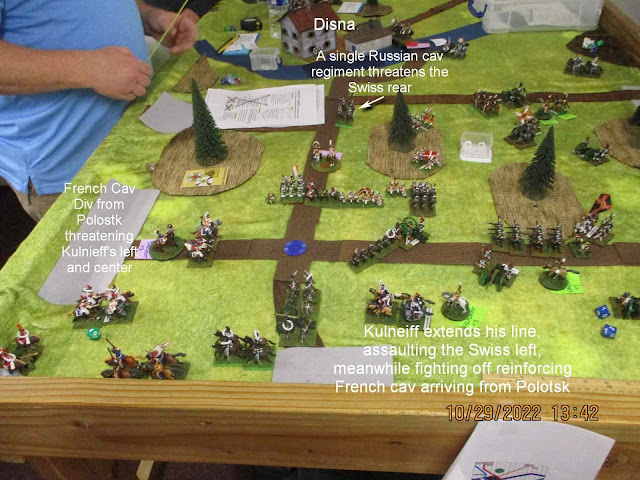



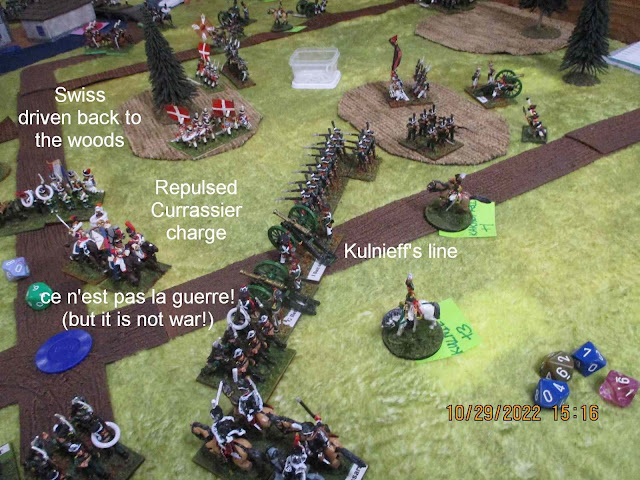
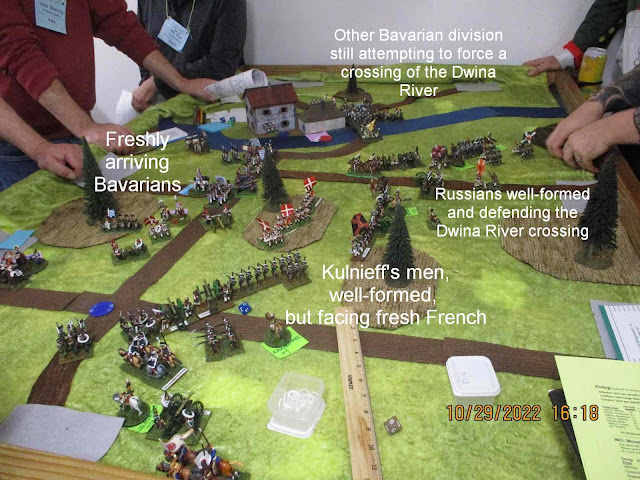
.jpg)

.jpg)
.jpg)
.jpg)
.jpg)
.jpg)
.jpg)
.jpg)
.jpg)
.jpg)
.jpg)
.jpg)
.jpg)
.jpg)
.jpg)
.jpg)
.jpg)
.jpg)
.jpg)
.jpg)
.jpg)
.jpg)
.jpg)
.jpg)


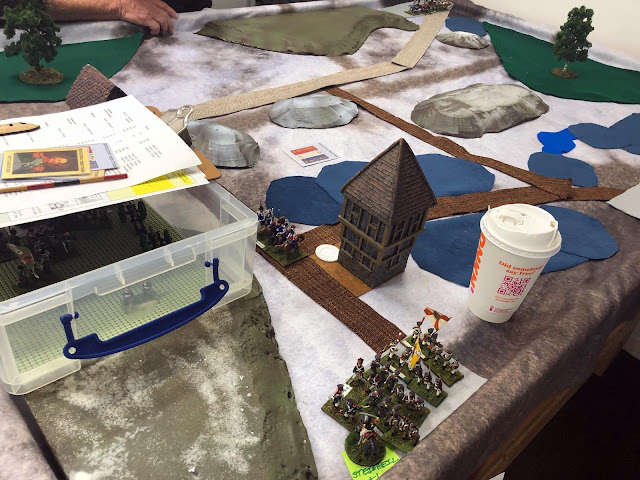









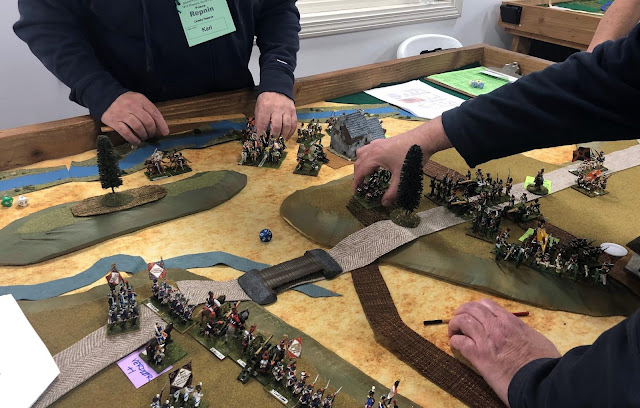







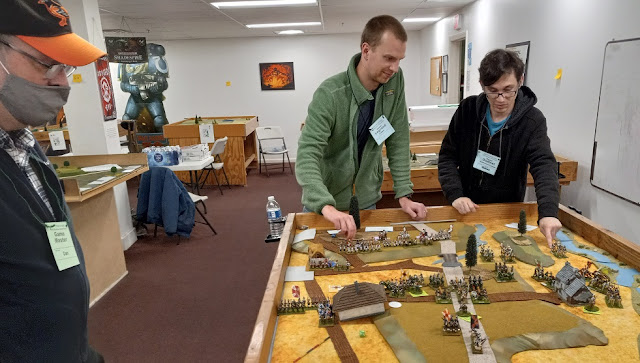











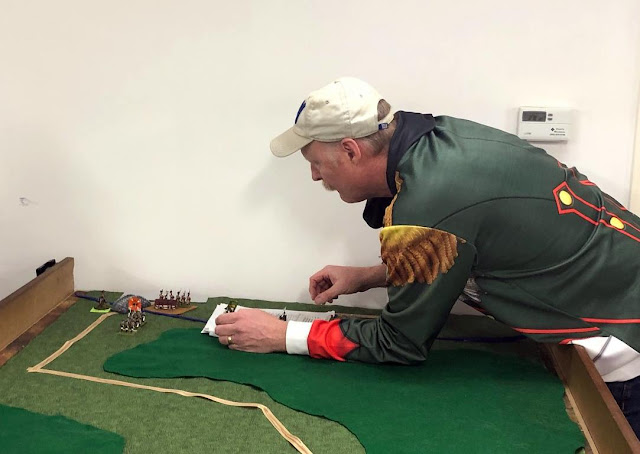






Some real fog of war going on with the maneuvering and the confusion over the maps. Those Swiss held out brilliantly, at least for a while. I would have been surprised to find they were elite as well.
ReplyDeleteMerle held out well , assisted by timely reinforcements over the course of the day.
DeleteAlways a tumultuous day. Setting up some tables a day early makes sense!
ReplyDeleteIt's a full day for sure, but at least this time I wasn't the lead GM, and had time to test build my four tables.
DeleteWhat a fantastic experience this days gaming must have been...outstanding work by all concerned!
ReplyDeleteThey are unique and special events!
DeleteExcellent reports. Great games yet with relatively small numbers of figures on modest tables. Not often one reads of spies duelling during a wargame :-)
ReplyDeleteThe spies were an outgrowth of the pregame. I included figures for both of them in the forces allotted to the C-in-C for the game.
Delete